These braised veal shanks with white beans and greens are the definition of effortless elegance at the dinner table. Just 15 minutes prep and a long braise for beautifully tender shanks that have all the stick-to-your-ribs comfort you're craving.

Cross-cut veal shanks are known mostly from the Italian kitchen where they're called ossobuco and most often prepared in the Milanese style as in Ossobuco alla Milanese and served with saffron risotto (Risotto alla Milanese) and gremolata.
But the beauty of this cut is that it's really fail-proof and can be prepared with different types of ingredients for an always tender, perfect slow roast.
The combination of slow braised veal shanks with brothy white beans and greens is not only exceptionally flavorful and elegant, but it's also a healthier approach to braised veal shanks with less fat and more fiber.
Ingredients
Besides the veal shanks, the other ingredients in this dish are quite simple, whole food ingredients that come together to complement the qualities of the veal shanks.
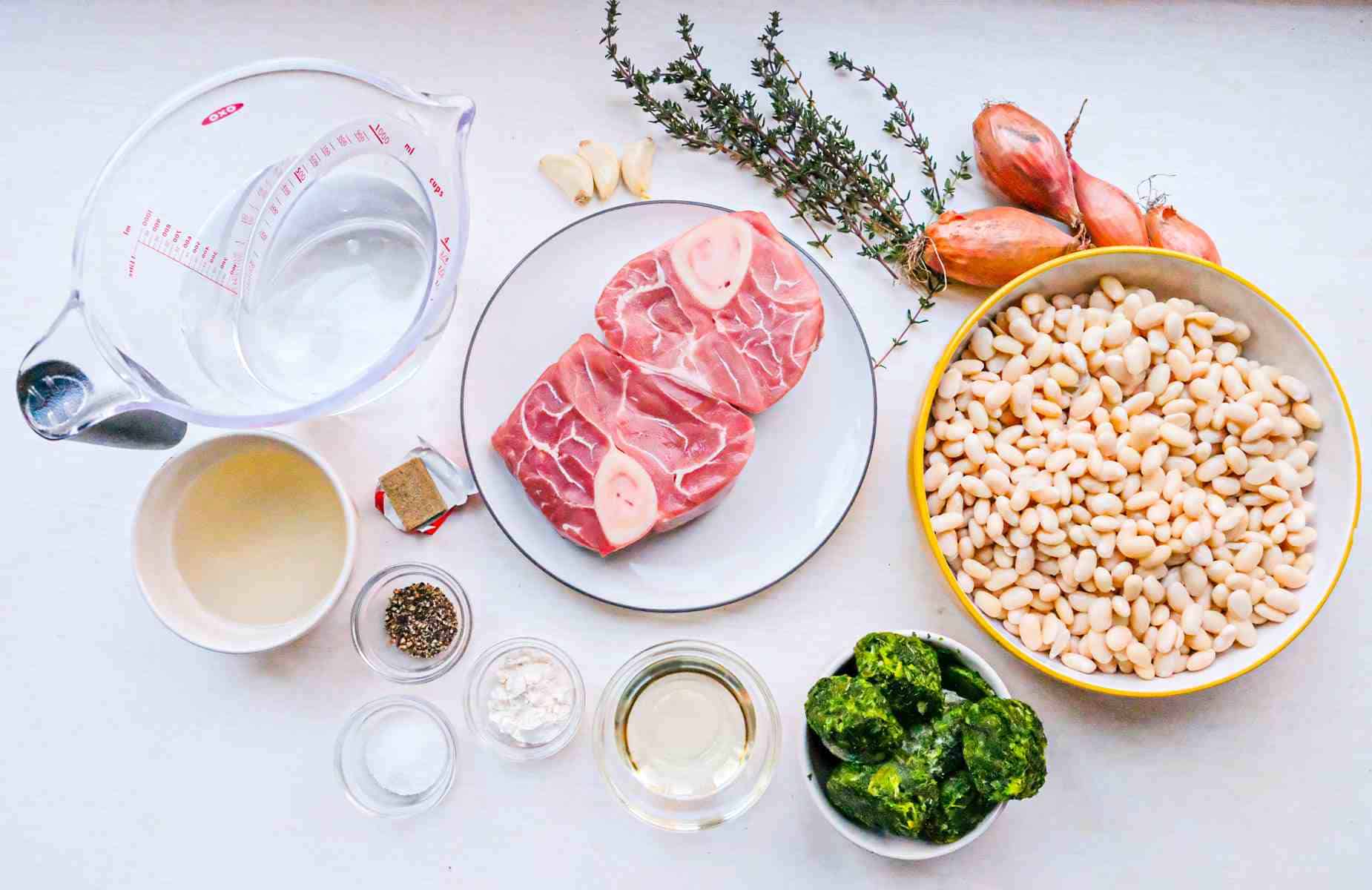
Cross-cut veal shanks
Cross-cut veal shanks (or ossobuco in Italian) are a really beautiful cut because they're basically never-fail tender when prepared with a long braise.
I can't think of any other cut that's so perfectly tender every time with such little hands-on effort.
Presoaked dry white beans
The variety of white bean is not so important. You can use lima beans, navy beans, cannellini beans, great northern beans etc.
Likewise, the quantity is not super important. About 3 cups dry beans will yield 3.5 presoaked beans. A little more or less won't make a big difference.
The only quite crucial element is that the beans be presoaked because then they will cook in the same amount of time as the veal shanks.
If you use canned beans, they may get mushy after 2-2.5 hours of braising. Likewise, if you use dry beans without presoaking, then they may not cook in the amount of time it takes to get the veal shanks tender.
If you really need to speed up the process, you can approximate the presoak by boiling the beans for about 40-45 minutes. Discard the liquid and you can use the beans.
You may need to roast for a bit more time than the recipe calls for (depending on the type of beans you use) so be sure to do a bite test at the 2 - 2.5 hour mark and see if the beans are fully cooked through.
Greens (kale, spinach etc.)
I used frozen kale for this recipe but you can substitute spinach or another green you prefer (maybe nettles or just mixed greens).
I used frozen because I have frozen greens on standby and they're in convenient little cubes that make it easy to toss them into recipes. You can also use fresh - just give them a thorough wash and rough chop.
Liquid: water, white wine and oil
Liquid in a key part of a braise. The main liquid in this recipe is a low-sodium buillon cube dissolved in water. You can substitute chicken, beef or veal stock or bone broth if you prefer, just be sure to adjust the quantity of salt accordingly.
The other liquids are oil (for browning the shanks and aromatics) and white wine (to deglaze the pan and bring extra flavor). White wine is preferred as the flavor of red would be on the heavy side for this dish. If you don't cook with wine feel free to skip this step (just substitute more water or stock).
Aromatics: shallots and garlic
The only aromatics in this dish are shallots and garlic. The shallots I get are quite tiny so I had to use four. If you have jumbo shallots then you may only need to use two. The overall quantity is about ¾ of a standard size measuring cup.
Seasoning: salt, black pepper, buillon, and fresh thyme
The seasoning is just salt, low-sodium chicken buillon, black pepper and fresh thyme. You can substitute dried thyme (use 2.5 teaspoons).
Flour
Regular white wheat flour is used in this recipe. The flour mixes with the liquid in the pot to thicken up the sauce. To make it gluten free you can substitute another thickener of your choice (like cornstarch or arrowroot) but you might want to whisk up a slurry by mixing it with a few teaspoons of liquid (this makes it less likely to have clumps) before adding the slurry to the pot.
Equipment
I recommend a heavy-bottomed pot with a lid that can go from stovetop to oven since you'll need to sear on the stovetop and then slow cook in the oven. I'd recommend cast iron in particular, like a Dutch oven or similar cast iron casserole with a lid.
I used my Le Creuset braiser which is pictured. The braiser pictured is 3.3 liter / 3.5 quart which is a good size for this recipe.
If you don't have a pot that can go from stovetop to oven then feel free to modify the recipe by searing the veal shanks on the stovetop in a skillet, deglaze with the white wine and then sauté the aromatics per the recipe card indications.
Once that step is done you can just put all the ingredients in your oven pot and continue the recipe as usual.
Instructions
This recipe is super easy to make considering how rustically elegant it looks. That's the beauty of recipes like this one - they give you basically effortless elegance.
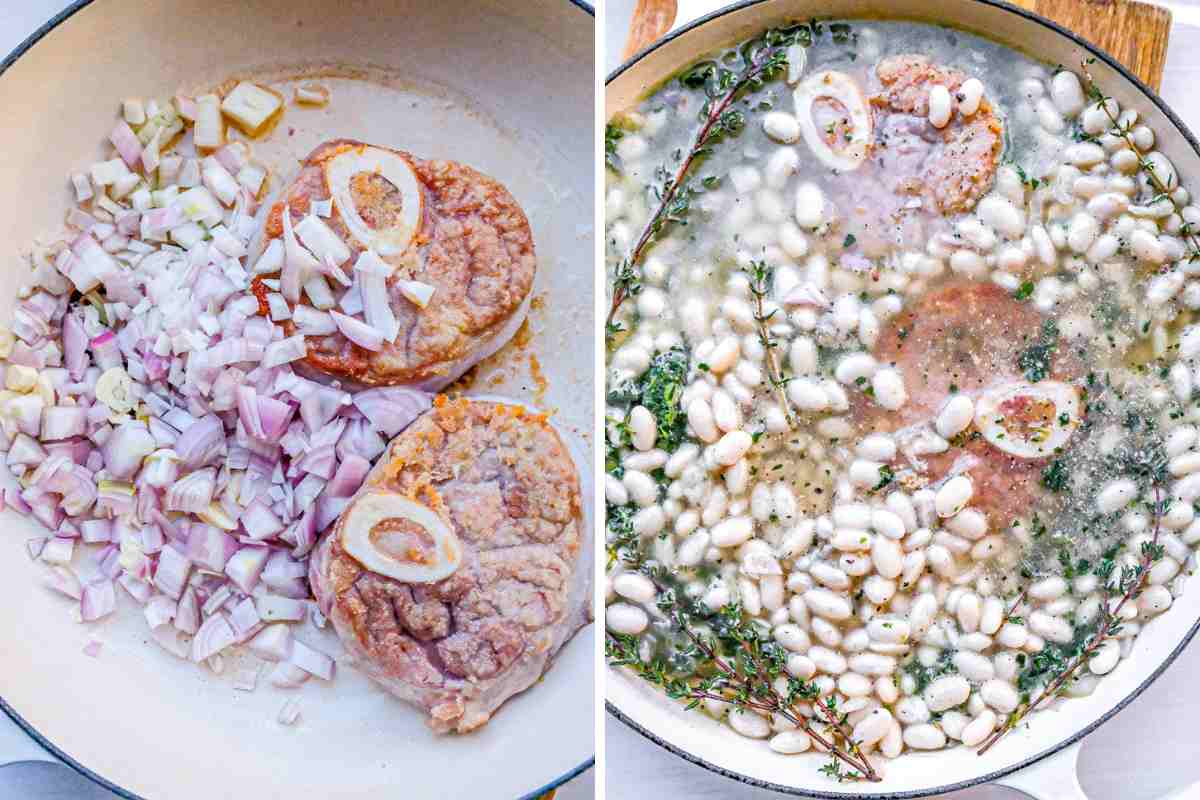
All you need to do is sprinkle the veal shanks with a bit of the salt and some flour, then sear them over relatively high heat to make a nice golden crust.
This step has two benefits. One is that you introduce some caramelization which develops new and more complex flavor compounds.
The second benefit is that you introduce starch (the flour) which combines with the liquids while cooking to make a richer and thicker sauce.
After searing the veal shanks, remove them to a plate and set aside for now. Then sauté the aromatics (the shallots and garlic) until lightly browned (again for some caramelization and extra flavor development).
Once the aromatics and golden and, well, aromatic, then you'll deglaze with the white wine. Pour it all in at once and it should sizzle vigorously and release a large plume of steam.
Once the steam has mostly evaporated, you can put the beans, kale, thyme, the rest of the seasoning and the water (with the dissolved buillon cube in it). Give it a stir to make sure it's all incorporated and then nestle the shanks in there about halfway into the liquid.
Cover and roast. That's all she wrote.
Serving Suggestion
These braised veal shanks and white beans are exceptionally flavorful. They go really well with a bit of shaved parmesan or pecorino added just before serving.
If you want a carb element, you can go as simple as some nice bread or buttery noodles (this was my preference and it was so good!), or go a bit further with saffron risotto or maybe creamy garlic parmesan polenta.
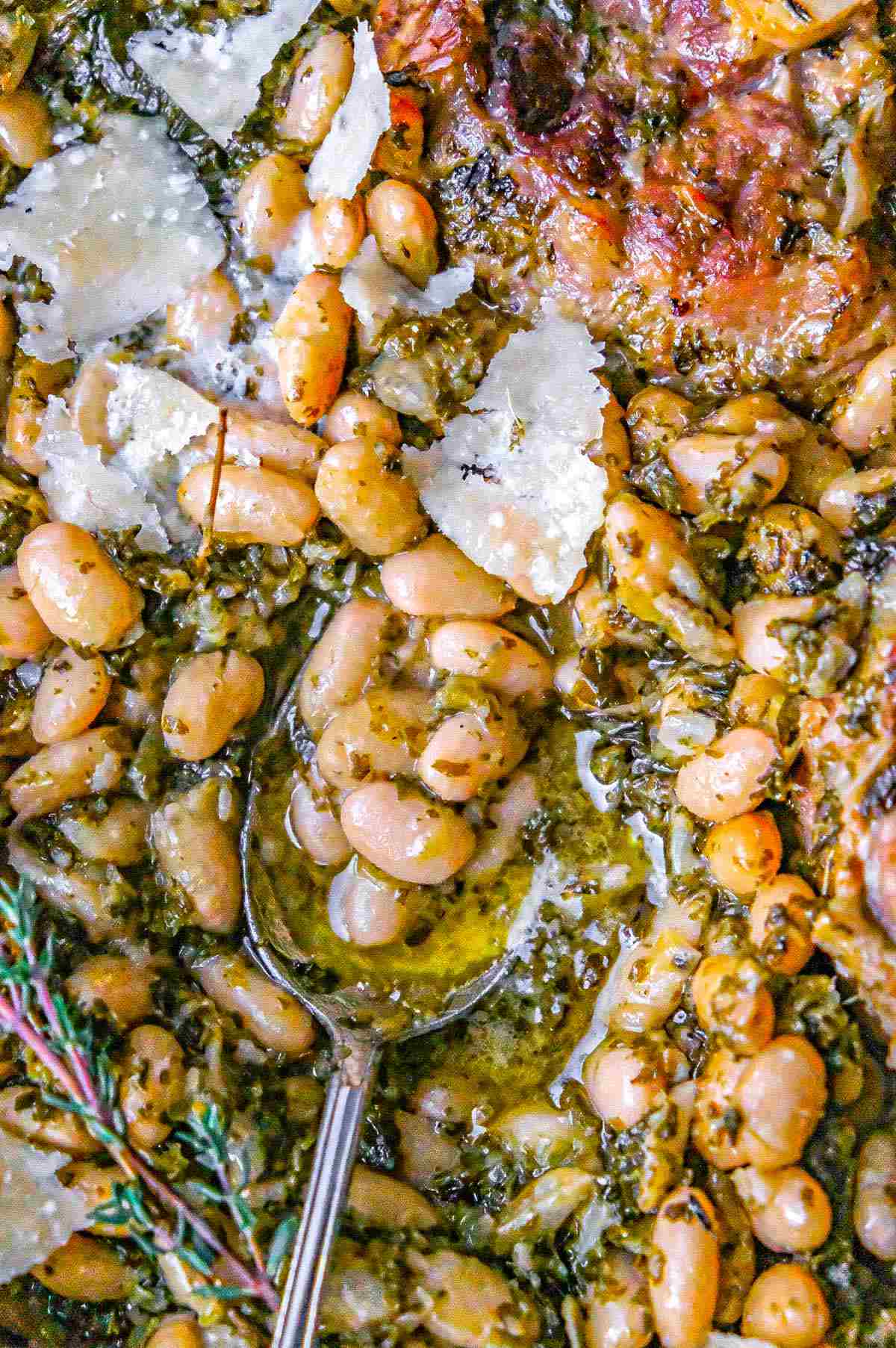
Related
Looking for more effortlessly elegant meals? Maybe you'll like one of these:
Recipe

Braised Veal Shanks with White Beans & Kale
Equipment
- heavy bottomed pot with lid that can go from stovetop to oven Dutch oven or similar cast iron casserole pot is a good option. See equipment note for other options.
Ingredients
- 500 grams veal shanks about 2 cross-cut shanks (1lb or so)
- 3.5 cups presoaked white beans about 700 grams / 25oz
- 1 cup kale or spinach, frozen or fresh
- 600 ml water about 2.5 cups
- 1 bouillon cube low-sodium
- 0.5 cup white wine
- 3 tablespoons oil vegetable or olive
- 2 teaspoons flour
- 4 shallots finely sliced
- 3 cloves garlic finely sliced
- 4 sprigs fresh thyme
- 2 teaspoons black pepper
- 2.5 teaspoons salt
Instructions
- Presoak the white beans for at least 8 hours or overnight.
- Preheat oven to 165 C / 330 F.
- Dissolve the bouillon cube in the water.
- Finely slice the shallots and garlic.
- Sprinkle the veal evenly on all sides with 1 teaspoon of the salt then with all of the flour.
- Heat the oil in the pot on medium-high to high heat. Sear the veal on all sides until lightly golden brown then remove it from the pot and set aside in a plate.
- Add the garlic and shallots to the pot and sauté a few minutes until softened, aromatic and beginning to brown lightly.
- Pour the white wine into the hot pan all at once to deglaze. Allow it to simmer until most of the steam has evaporated and then put in the beans, kale, thyme, the rest of the seasonings and the water. Give it a stir to combine everything evenly then place the veal shanks back in the pot.
- Cover and put in oven for 2 hours. After 2 hours everything should be nicely golden and the veal shanks should be very tender. If not, then uncover and continue roasting another 30 minutes - add another half cup water if the liquid reduces so much that the stew is sticking.
- When ready remove from oven, allow to cool for 5-10 minutes and then taste and adjust seasoning to your preference (maybe you want more salt or black pepper).

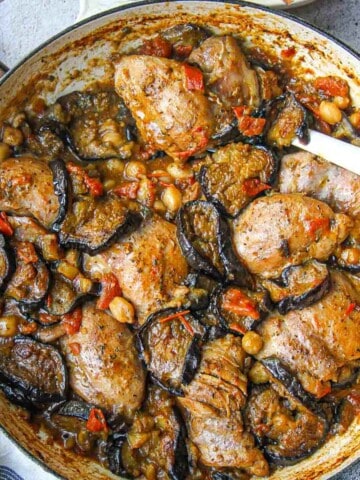
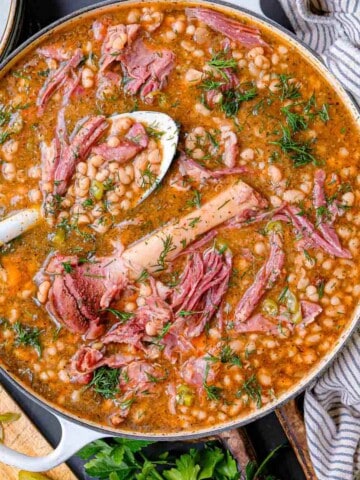
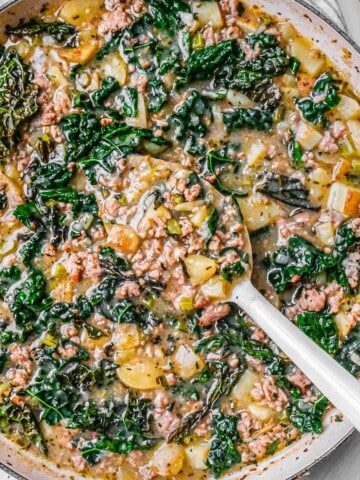


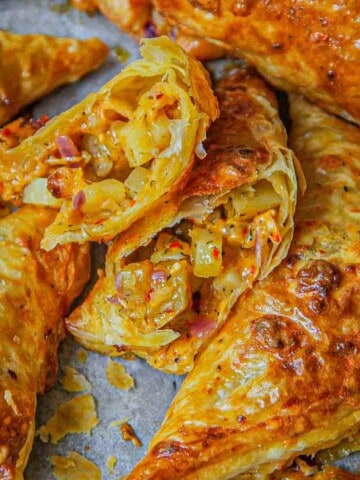
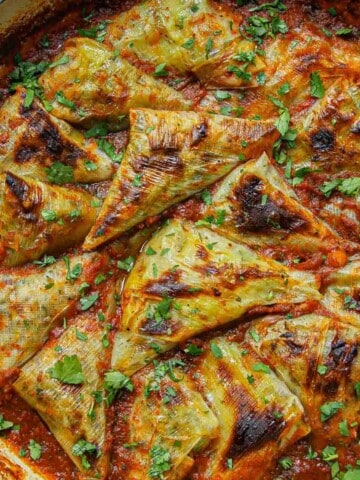
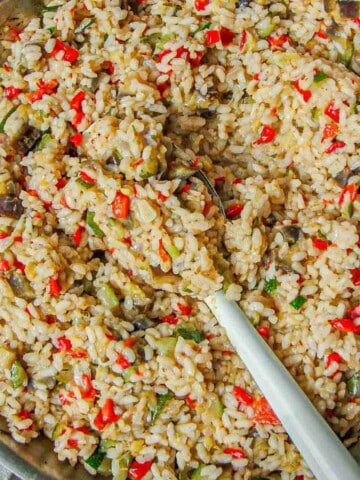
Comments
No Comments